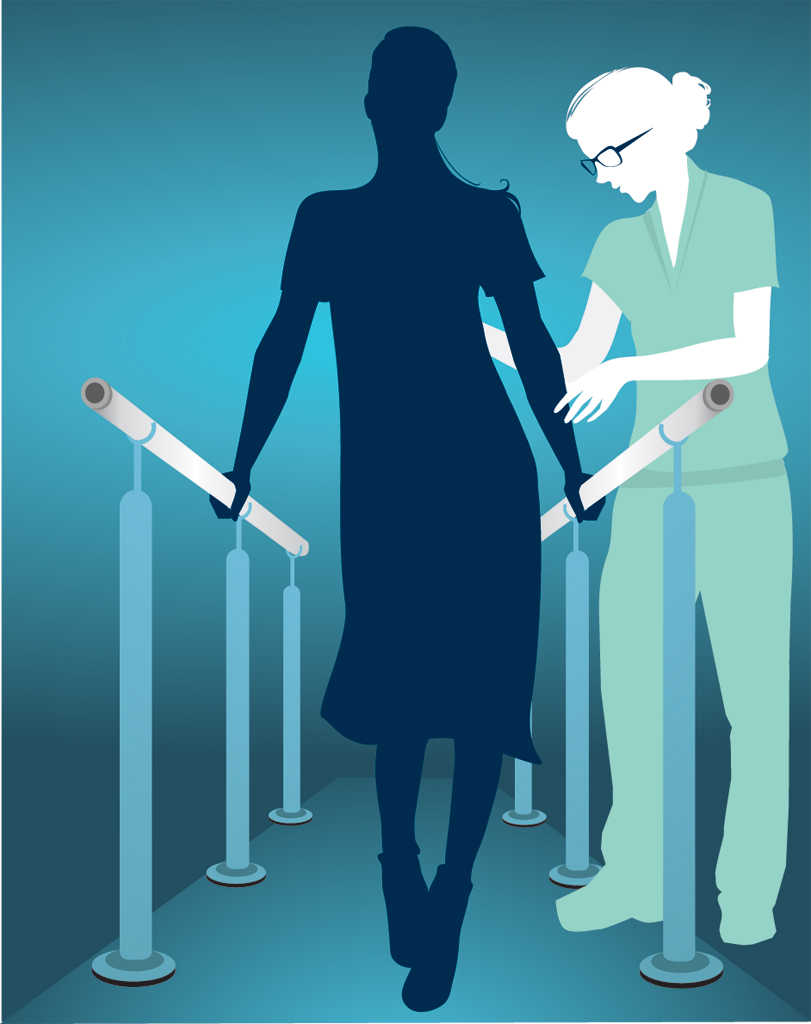By Lisa Baptis, PT
When you have osteoporosis, just doing the laundry can be back breaking work — literally.
Even the simplest movements performed incorrectly can increase the risk of fragile bones fracturing.
Physical therapy, however, can help prevent injury by improving posture, balance, and strength and by educating patients on how to use proper body mechanics to perform routine tasks safely.
At Penn Medicine Princeton Medical Center Princeton Rehabilitation, specially trained physical therapists offer osteoporosis patients individualized care to help treat osteoporosis and reduce the risk of fracture.
A Silent Disease
One in three women and one in five men over the age of 50 will develop osteoporosis in their lifetime, according to the Centers for Disease Control and Prevention.
Called a silent disease because it usually doesn’t have any obvious symptoms, osteoporosis causes bones to weaken and become prone to fracture. Osteopenia, a condition in which bone density is lower than average for your age, is a precursor to osteoporosis.
Age is the biggest risk factor for osteoporosis. As you get older, your body starts to lose more bone mass than it can rebuild, and in some people, this can lead to porous bones or osteoporosis.
Other risk factors for osteoporosis include:
• Being post-menopausal.
• Cigarette smoking.
• Being confined to a bed or having prolonged immobility.
• Rheumatoid arthritis, chronic kidney disease, and eating disorders.
• Certain medications such as prednisone or some anti-seizure medications.
• Hyperparathyroidism.
Osteoporosis affects men and women of all races, but non-Hispanic white and Asian women— especially older women who are past menopause — are at highest risk, according to the National Institutes of Health.
Fracture Normally First Sign
Many people are unaware they have osteoporosis until they suffer a fracture. As the disease progresses, you may experience:
- Bones that fracture easily.
- Loss of height; getting shorter by an inch or more as you age.
- Persistent low back or neck pain.
- Change in posture, such as stooping or bending forward.
Without appropriate treatment, osteoporosis can worsen as you age. As your bones get thinner and weaker, the risk of fracture increases.
Physical Therapy Can Help
For women and men over age 50, a DEXA scan, which is a type of X-ray that tests bone strength and density, is generally recommended to determine if you have osteoporosis.
If you are concerned about your risk for osteoporosis, talk with your primary care physician. They will determine whether you need a scan and provide you a prescription. The scan is typically covered by most insurance plans.
Depending on the result of the scan, your doctor may recommend follow up testing every year or two to continue to monitor your bone health.
Patients who are diagnosed with osteoporosis are usually referred to physical therapy by their rheumatologist or primary care physician. Because low levels of estrogen associated with menopause contribute to a reduction in bone density, a woman may also receive a referral for physical therapy from her gynecologist.
Working with a physical therapist can help:
• Improve your balance.
• Reduce your risk for falls.
• Stretch and strengthen your muscles.
• Correct stooped posture.
• Reduce pain.
Additionally, recent studies suggest that exercise increases bone density, which can help prevent and reduce fracture risk.
At Princeton Rehabilitation, physical therapy for osteoporosis starts with a thorough physical assessment along with education about the disease.
Physical therapists work with patients on specific exercises to strengthen the muscles in the back, shoulders, hips and abdomen, which provide support for the spine and neck. These exercises help with balance, lengthen the spine to reduce spinal compression, and increase bone density.
Training includes reeducation on postural alignment and how to use proper body mechanics to bend, lift, and reach so you can safely perform everyday activities such as vacuuming, getting in and out of car, and putting groceries away.
Several of the most effective types of exercise for increasing bone density in people with osteoporosis include weight-bearing (aerobic exercises) such as stair climbing or walking, and resistance training exercises, such as lifting weights. As therapy progresses to more advanced exercises, therapists will provide instruction on what to do as well as what not to do.
Typically, the exercises learned in physical therapy do not require special equipment so they can easily be continued long-term at home.
Therapy sessions are usually recommended twice a week for several weeks and then begin to taper off and be replaced with a program that you can do at home. Patients are reevaluated several times throughout the program to track progress and make any necessary adjustments in their therapy plan. Most major insurance plans cover physical therapy sessions.
A diagnosis of osteoporosis can change your life, but physical therapy can help prevent the progression of the disease, improve bone density, and reduce your risk for fracture.
Together with your doctor’s recommendations for a healthy diet, exercise, medication, and appropriate lifestyle changes, physical therapy can help improve your quality of life as you age.
Physical therapy is one of several services offered as part of Penn Medicine Princeton Medical Center’s Osteoporosis Program, designed to increase awareness and provide education on the importance of early diagnosis and treatment of osteoporosis.
For more information, or to find a physical therapist with Princeton Rehabilitation, call 609-853-7840 or visit www.princetonhcs.org.
Lisa Baptis, PT, is a physical therapist with Princeton Rehabilitation at Princeton Medical Center

